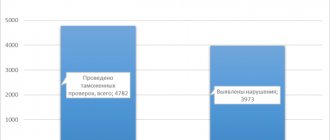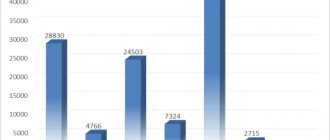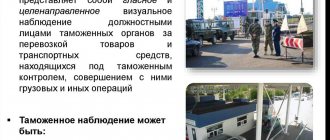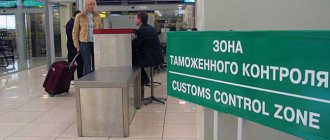Organization of customs control over the import and export of licensed goods
The relevance of the research topic is due to the fact that due to the unstable global political and economic situation (we are talking in particular about the sanctions of individual states against Russia and its countermeasures [8]) and, in this regard, the need to use, along with customs tariff methods regulation, as well as prohibitions and restrictions in order to protect the internal market.
At the same time, “the role of the system of prohibitions and restrictions is steadily growing, which requires its constant improvement” [7, p. 94].
One of these elements of this system of prohibitions and restrictions is the licensing of the import and export of certain goods, which primarily involves protecting the domestic market from the uncontrolled export of raw materials, regulating the export of material natural resources, and controlling the transfer of foreign currency earnings.
Licensing can often be used as a preventive measure against unscrupulous competitors among national producers. This measure is implemented on the basis of generally accepted regimes in the world community, including the relevant provisions of the Import Licensing Agreement and the World Trade Organization [1].
In the modern period, the world experience of foreign countries in the field of trade is aimed at improving administrative instruments for regulating foreign trade activities. Non-tariff regulation is often used to fulfill international obligations, as well as in exceptional cases, for example, to protect the national economy [5].
The state, being in a market economy, directly interferes with the country's trade activities through the use of licenses, quantitatively limiting the size of imports, and in some cases completely prohibiting the import of certain goods. In the absence of customs duties or their irrational use or impact, in order to achieve equalization of foreign trade and balance of payments, an objective need arises for licensing foreign trade operations, which allows for the effective use of foreign currency.
Import and export licensing as an instrument of state regulation of foreign trade activities has a number of features. In this situation, a special permit is necessary not only for carrying out activities related to the export and import of goods, but for the export and import of certain species, the lists of which are determined, first of all, by the economic interests of the state.
Lists of licensed goods are introduced by the legislation of the Eurasian Economic Union (hereinafter referred to as the EAEU) [30]. The unified list consists of goods prohibited for movement across the border of the EAEU, and goods restricted for movement across the border of the EAEU (that is, licensed).
The procedure for licensing the export and import of goods applies to all participants in foreign trade activities, regardless of the form of ownership, place of registration and market position. Moreover, as about [9, p. 121].
The Ministry of Trade of the Russian Federation issues licenses through its authorized representatives in the regions, and only in some cases issuance is carried out through the authorized representative for the Central District.
A license is a document (agreement) that gives the right to carry out foreign trade operations with certain categories of goods, and licensing itself, along with quantitative restrictions, is “the most effective way of non-market direct and flexible regulation of exports and imports” [6].
Quotas and licenses control the independence of enterprises in the field of trade with third countries, limit the range of countries with which transactions can be concluded on certain goods, and regulate the range and quantity of goods allowed for import and export.
To obtain a license, a participant in foreign trade activities submits the following documents:
application for a license in the form in one copy on paper and in electronic form;
a copy of the agreement formalizing the foreign trade transaction (only in the case of a one-time license);
a copy of the certificate of registration with the tax authority;
a copy of the license to carry out a licensed type of activity, if such type of activity is related to the circulation of goods for which licensing has been introduced on the territory of a member state of the EAEU;
other documents, if they are specified in the legal acts on the basis of which licensing of this product was introduced [4].
The licensing system is used for the purpose of operational control over compliance with quotas. However, it is used by many countries as an independent means of non-tariff protectionism. Licensing allows the state to actively intervene in the formation of the volume, commodity and geographical structure of trade and economic activity of those involved in foreign trade activities.
After the import (export) of goods in quantities corresponding to the quota specified in the license, or after the expiration of the license, the license execution sheet, signed by the head of the customs post, transfers copies of the license to the customs department, which verifies the information specified in the execution sheets with data from the Journal registration of copies of licenses.
The customs department of copies of licenses, after receiving all the sheets of execution of the license and filling out the back side of the copy of the license, sends to the customs department of the original license copies of the sheets of execution with a covering letter signed by the head of the department, which indicates the total quantity of goods released by customs under the license. The date and originating number of the letter are entered on the back of the license copy. Copies of licenses and execution sheets are stored in customs departments in special folders by serial numbers. Licensed goods must be moved across the customs border of the EAEU before the license expires. Compliance with this condition is confirmed by a copy of the front side of the original license, certified by the customs office of the original license and presented by the owner of the license to the customs authorities located at the border checkpoints through which goods are moved on account of the license. The validity period of a license to export goods can be controlled using a copy of the customs declaration submitted to the customs authority located at the border checkpoint (Fig.).
The license holder, or a person duly authorized by him, simultaneously with the original license, submits to the customs authority a written application for issuing a license in any form.
Rice. Scheme for monitoring the exhaustion of a license quota or the expiration of a license
The license is issued for control within a period not exceeding three working days from the date of registration of the application with the customs authority.
The movement of licensed goods across the customs border of the EAEU and the filing of a customs declaration is carried out within the validity period of the license. The quantity of goods is written off against the license upon its release in accordance with the first declared customs procedure, except for the customs transit procedure.
Introducing and applying for adjustments that relate to the names of licensed goods and (or) changing their quantity for each customs authority in which it is planned to make customs declaration of licensed goods against the license, the license holder is obliged to submit to the customs authority that issued the license for control a new application with the amendments made, to which documents must be attached, copies of the license certified by the customs authority that were not previously submitted to the customs authority during the customs declaration of the goods specified in them.
The customs authority terminates the release of licensed goods in cases of depletion of the quantity specified in the certified copy of the license, redistribution of the quantity of goods indicated on the reverse side of the certified copy of the license between customs authorities, or a change in the customs authorities in which it is planned to make customs declaration of licensed goods against the license.
Features of control of import into the customs territory of the EAEU and export from this territory of licensed goods, including issuing licenses for control and removing them from control, recording the number of goods imported (exported) according to these documents, when making customs declarations using a customs declaration in the form electronic document and software that provide automated control over the execution of licenses, as well as in cases where licensed goods are imported (exported) across the state border of a member state of the EAEU, can be determined by state authorities authorized in the field of customs affairs.
Literature:
- Agreement on import licensing procedures. Concluded in Marrakesh on April 15, 1994 // Legal reference system “Consultant Plus”.
- Customs Code of the Customs Union (as amended on May 8, 2015) (annex to the Agreement on the Customs Code of the Customs Union, adopted by the Decision of the Interstate Council of the EurAsEC at the level of heads of state dated November 27, 2009 No. 17) // Reference and legal system “Consultant Plus”.
- Decision of the Board of the Eurasian Economic Commission dated April 21, 2015 No. 30 (as amended on November 17, 2015) “On measures of non-tariff regulation” // Reference and legal system “Consultant Plus”.
- Decision of the Customs Union Commission dated June 22, 2011 No. 687 “On the Regulations on the unified procedure for control by customs authorities of the import into the customs territory of the Customs Union within the framework of the EurAsEC and the export from this territory of licensed goods” // Reference and legal system “Consultant Plus”.
- Baklakov P.A. Prohibitions and restrictions on foreign trade activities. Textbook / P.A. Baklakov, E.V. Zybina, N.A Stepura, A.V Kuleshov, V.A. Gaifutdinov, O.V. Shishkina. SPb: IC "Intermedia". 2014. 896 p.
- Velyaminov G.M. International law: experiments. M.: Statute, 2015. 1006 p.
- Vorotyntseva T.M. Control by customs authorities over the movement of goods of animal and plant origin: Textbook. allowance. M.: Publishing house of the Russian Customs Academy, 2014. 100 p.
- Glekova V.V., Kostin A.A., Kostina O.V., Moskalenko O.A. Forcing the intercountry “blockade”: the development of Russian foreign trade in the conditions of economic sanctions // Innovations and investments. 2015. No. 5. P. 104-110.
- Prokushev E.F., Kostin A.A. Foreign economic activity: Textbook and workshop. 9th ed., trans. and additional M.: Publishing House Lawyer, 2015. 537 p.
Movement of licensed goods across the customs border of the Customs Union: control procedure
By decision of the Customs Union Commission dated June 22, 2011 No. 687, the Regulations on the uniform procedure for control by customs authorities of the import into the customs territory of the Customs Union within the framework of the EurAsEC and the export from this territory of licensed goods (hereinafter referred to as the Regulations) were approved. If goods subject to restrictions are moved across the customs border of the Customs Union on the basis of permits other than licenses, the Regulation in question does not apply, and the specified permits are presented when performing customs operations in accordance with the customs legislation of the Customs Union. Here are the key provisions of the unified procedure for monitoring the execution of licenses established within the Customs Union, effective from July 1, 2011.
Unless otherwise established by the provisions on the application of restrictions, approved. By the decision of the Board of the Eurasian Economic Commission dated August 16, 2012 No. 134 “On regulatory legal acts in the field of non-tariff regulation”, before the movement of licensed goods across the customs border of the Customs Union, and if non-tariff regulation measures are established in relation to licensed goods, before submitting a declaration to goods, the license holder submits its original for control to the customs authority of the member state of the Customs Union in whose territory the license holder is registered , namely :
- to the customs authority, subordinate to which are the customs authorities (structural divisions), in which it is planned to carry out customs declaration of all licensed goods;
- to the customs authority at the location of the license holder, if it is planned to make customs declaration of licensed goods in customs authorities (structural divisions) subordinate to different customs authorities.
Simultaneously with the original license, the owner of the license or a person duly authorized by him submits to the customs authority a written application for issuing a license for control in any form , which must contain the following information : - names of the customs authorities subordinate to which the customs authorities (structural divisions) are located, in which it is planned to carry out customs declaration of licensed goods; – the quantity and name of goods imported (exported) under a license for each customs authority (structural unit) in which it is planned to carry out customs declaration of licensed goods. The following documents are attached to the written application : 1) copies of the front side of the original license, the number of which must correspond to the number of customs authorities (structural divisions) in which it is planned to carry out customs declaration of licensed goods; 2) a copy of the front side of the original license for its subsequent submission to the customs authorities in the regions of activity of which the places of arrival (departure) of goods to the customs territory of the Customs Union are located. The reverse sides of license copies intended for presentation during customs declaration must contain the information specified in the written application in accordance with the established form (Appendix 1 to the Regulations) . This information is additionally presented electronically in RTF format according to the structure given in the appendix. 2 to the Regulations. The license is issued for control within a period not exceeding three working days from the date of registration of the application with the customs authority . The customs authority may refuse to issue a license for control if it is not authorized to perform such actions, if not all documents and information provided for by the Regulations are submitted, or if the submitted documents are not drawn up in a manner that complies with the Regulations, or if inconsistencies are identified with the information contained on the reverse side copies of the license, information specified in the original license and its annex. In case of refusal to issue a license for control, the customs authority, within a period not exceeding three working days from the date of registration of the application with the customs authority, sends to its owner a written refusal to issue a license for control, attaching the original license and indicating the basis for such refusal. Unless otherwise established by the legislation of the member states of the Customs Union, appendices (lists) of goods attached to licenses, the import (export) of which is carried out in accordance with foreign trade agreements concluded by the license holder, are also subject to control in the prescribed manner. After the license is issued for control, its original remains with the customs authority, and certified copies submitted to the customs authority are returned (sent) to its owner no later than two working days after the license is issued for control. Copies of the license certified by the customs authority must contain the following marks from the customs authority: a stamp imprint or the entry “Put under control”; signature and personal numbered seal of the customs official who issued the control license; date of issue of the control license; number assigned when applying for a control license. Marks from the customs authority are placed on the front side of license copies in the upper right corner or in another free space. At the same time, on copies of the license intended for presentation during customs declaration, the number assigned when the license is issued for control is located on the reverse side of the copy of the license in accordance with Appendix. 1 to the Regulations. Certified copies of the license are submitted to :
- at the place of arrival (departure) together with transport (transportation) and (or) commercial documents for each consignment of goods moved across the customs border of the Customs Union;
- to the customs authority (structural unit) in the set of documents for the declaration of goods, according to which the customs declaration of the licensed goods is carried out against the license for the first time, while a copy remains with the customs authority. Subsequent customs declaration in this customs authority (structural unit) of licensed goods against the license is carried out indicating information about the license in the goods declarations without submitting copies of it, except for the cases provided for in clause 12 of the Regulations (see below).
Unless otherwise established by the provisions on the application of restrictions, approved. By decision of the Board of the Eurasian Economic Commission dated August 16, 2012 No. 134 “On regulatory legal acts in the field of non-tariff regulation”, goods for which the original licenses have not been put under control in accordance with the Regulations not allowed to move across the customs border of the Customs Union , and in if non-tariff regulation measures are established in relation to licensed goods , they are not subject to release by customs authorities . The release of licensed goods is carried out in accordance with the names of goods indicated on the back side of the certified copy of the license, and in quantities not exceeding the quantity of licensed goods indicated on the back side of the certified copy of the license. The quantity of goods is written off against the license upon its release in accordance with the first declared customs procedure, except for the customs procedure of customs transit. The customs authority (structural unit) terminates (does not allow) the release of licensed goods in cases of exhaustion of their quantity specified in the certified copy of the license, redistribution of the quantity of goods indicated on the reverse side of the certified copy of the license between customs authorities (structural units) or changes in customs authorities ( structural divisions) in which it is planned (is) customs declaration of licensed goods against the license. In accordance with clause 12 of the Regulations, in cases of redistribution of the names and quantities of goods indicated on the back of copies of the license between customs authorities (structural divisions) or changes in customs authorities (structural divisions) in which it is planned to carry out (is carried out) customs declaration of licensed goods in account of the license, the license holder is obliged to submit to the customs authority that issued the license for control a new application with amendments, to which the documents provided for by the Regulations must be attached, taking into account the said changes, as well as copies of the license certified by the customs authority that have not previously been submitted to the customs authority (structural division) during customs declaration of the goods specified therein. Certification by the customs authority and issuance of copies of the license are carried out within a period not exceeding three working days from the date of registration of the new application, if the information on the quantity and nomenclature of licensed goods specified in the new application and the copies attached to it corresponds to the information on the quantity and nomenclature of licensed goods, which were not released against the license. Making adjustments to the application regarding changes in the quantity and (or) name of licensed goods for each customs authority (structural unit) in which customs declaration of licensed goods is planned (is being carried out) entails the termination of customs operations aimed at the release of licensed goods until submission of certified copies of licenses containing relevant changes. The customs authority (structural unit) stops (does not allow) the release of goods on account of a license, the validity of which is suspended (terminated), from the date of receipt of notification of such suspension (termination). The customs authority (structural unit) releases goods against the license, the validity of which has been renewed, from the date of receipt of notification of such renewal. When a license is removed from control, the customs authority that placed the license under control, based on a written application from the license holder, within a period not exceeding five working days, sends the license holder a certificate of execution of the license in the prescribed form. A certificate of execution of a license can be submitted electronically in accordance with the legislation of a member state of the Customs Union.
In conclusion, we note that the features of control over the import into the customs territory of the Customs Union and export from this territory of licensed goods, including issuing licenses for control and removing them from control, recording the number of goods imported (exported) under these documents when making customs declarations using a customs declaration in the form of an electronic document and (or) software that provides automated control over the execution of licenses, as well as in cases where licensed goods are imported (exported) across the state border of a member state of the Customs Union, on the territory of which their declaration will be carried out , without moving across the territory of other member states of the Customs Union, can be determined by government bodies of the member states of the Customs Union authorized in the field of customs affairs. In particular, in the Republic of Belarus the provisions of the Instruction on the procedure for submitting special permits (licenses) to customs authorities and monitoring compliance by legal entities and individual entrepreneurs with the procedure for quotas and licensing the export and import of goods, approved. Resolution of the State Customs Committee of the Republic of Belarus dated March 28, 2003 No. 25 “On measures to monitor compliance by legal entities and individual entrepreneurs with the procedure for quotas and licensing of export and import of goods.”
customs control
Currently, the Russian Federation is a member state of the Customs Union. The single customs territory of the Customs Union consists of the territories of the Republic of Belarus, the Republic of Kazakhstan and the Russian Federation. The limits of the single customs territory of the Customs Union are the customs border of the Customs Union. The movement of goods across the customs border of the Customs Union is regulated by the customs legislation of the Customs Union.
The customs legislation of the Customs Union defines the following concepts:
Product
- any movable property moved across the customs border, including storage media, currency of the member states of the Customs Union, securities and (or) currency values, traveler's checks, etc.
Goods for personal use
- goods intended for personal, family, household and other needs of individuals not related to business activities, transported across the customs border in accompanied or unaccompanied baggage or in another way.
Indivisible goods for personal use
- goods for personal use, weighing more than 35 kilograms, consisting of one unit or one set of goods, including those transported in disassembled, unassembled, incomplete or unfinished form, provided that the goods have the basic property of an assembled, complete or completed product.
Accompanied baggage
— goods for personal use, including hand luggage, directly transported by an individual crossing the customs border.
Unaccompanied baggage
- goods for personal use belonging to an individual, transferred or transferred to the carrier under an international transportation agreement (transport expedition) for actual movement across the customs border in connection with the entry of this individual into the territory of the Customs Union or his departure from the customs territory of the Customs Union.
When traveling across the customs border of the Customs Union by air, they are subject to customs declaration
(passenger customs declaration is filled out):
- Imported goods, the customs value of which exceeds 10,000 euros in equivalent and (or) the total weight of which exceeds 50 kg;
- Imported and exported cash (banknotes, treasury notes, coins, with the exception of coins made of precious metals) and (or) traveler's checks for a total amount exceeding the equivalent of 10,000 US dollars;
- Imported and exported monetary instruments (bills, bank checks, securities);
- Precious metals: temporarily imported, exported (with the exception of temporarily exported jewelry);
- Precious stones: temporarily imported, exported emeralds, rubies, sapphires, alexandrites, natural pearls in raw (natural) and processed form, unique amber formations;
- Cultural values;
- Exported state awards of the Russian Federation;
- Endangered animals and plants, their parts, as well as products obtained from them;
- Weapons and ammunition;
- Urns with ashes (ashes), coffins with bodies (remains) of the dead;
- Imported alcoholic beverages in quantities exceeding 3 liters;
- Narcotic drugs and psychotropic substances in the form of medicines for medical reasons with the appropriate documents;
- Radio-electronic devices and (or) high-frequency devices for civilian use, including those built-in or included in other goods;
- Technical means with encryption functions;
- Goods for personal use received as an inheritance, subject to documentary confirmation of the fact of receiving such goods as an inheritance;
- Goods for personal use imported in accompanied baggage, if the individual transporting them has unaccompanied baggage;
- Other goods defined by the customs legislation of the Customs Union.
An individual has the right, at his own discretion, to declare in writing goods that are not subject to customs declaration in writing.
The declarant of goods transported across the customs border can be either a person from a member state of the Customs Union or a foreign person.
Customs declaration of goods for personal use of an individual under 16 years of age is carried out by the person accompanying him (one of the parents, adoptive parents, guardian or trustee of this person, and in case of organized departure (entry) of a group of minors - the leader of the group).
Failure to submit a customs declaration in respect of the above goods is considered as a statement that an individual does not have goods subject to customs declaration.
Detection of goods subject to customs declaration during selective customs control entails holding the passenger accountable in accordance with the legislation of a member state of the Customs Union.
Reporting false information in a passenger customs declaration entails liability in accordance with the legislation of a member state of the Customs Union (administrative, criminal).
The submission of a passenger customs declaration must be accompanied by the submission to the customs authority of documents confirming the information stated in it.
Documents confirming the information stated in the declaration include:
- identity documents (including those of a minor);
- documents confirming the adoption, guardianship or trusteeship of a minor;
- documents confirming the value of the declared goods for personal use;
- transport (shipping) documents;
- documents confirming the right to benefits for the payment of customs duties, including confirming the temporary import (export) by an individual of goods for personal use, as well as confirming the recognition of an individual as a refugee, forced migrant or moving to a permanent place of residence
- documents confirming compliance with the restriction, except for non-tariff and technical regulation measures;
- documents containing information allowing to identify a vehicle for personal use;
- documents confirming the right to own, use and (or) dispose of a vehicle for personal use;
- other documents and information, the presentation of which is provided in accordance with the customs legislation of the Customs Union.
In the absence of goods subject to customs declaration, the above documents are presented at the request of a customs official.
Goods for personal use exported by individuals from the customs territory of the Customs Union are not subject to customs duties, taxes at uniform rates and aggregate customs duties.





